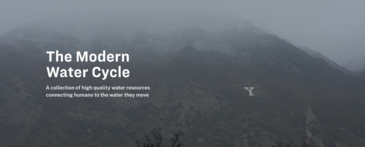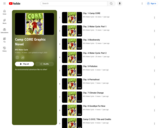Updating search results…

The resources in this collection were created as part of Brigham Young University’s Modern Water Cycle project. The collection includes high-quality water resources connecting humans to the water they move. The resources emphasize the two-way connection between humans and water.
13
affiliated resources

This resource is a YouTube playlist with videos to accompany the Camp C.O.R.E. graphic novel from the Modern Water Cycle collection by BYU and the USGS. The novel takes students through a scientific adventure in ecosystem science and includes chapters about the water cycle, biodiversity, pollution, permafrost, and climate change. Humans are a critical part of the global ecosystem and impact many aspects of it through our lifestyles. Each chapter covers an area where recent research has highlighted our influence and potential consequences of the status quo. We wrote this novel as a fun way to introduce this information to a younger audience in a more friendly format. The videos are another way to access the content of the novel. To download a copy of the novel itself, search “Camp C.O.R.E. graphic novel” in eMedia or visit the BYU Modern Water Cycle website.
- Subject:
- Science
- Material Type:
- Media Object
- Author:
- Brigham Young University
- Date Added:
- 08/21/2024

This resource includes posters and images from the Modern Water Cycle collection by BYU and the USGS. The resources highlight the different ways humans influence how water moves. Each image highlights direct human links to the water cycle. Blue Water deals with human water movement. Green Water highlights water that is moved through plants and agriculture including livestock. Gray Water is used to dissolve pollutants and often involves water quality issues or excessive heat.
- Subject:
- Science
- Material Type:
- Diagram/Illustration
- Author:
-
Katie Blunt
- Date Added:
- 08/21/2024

This resource includes a graphic novel from the Modern Water Cycle collection by BYU and the USGS. The resource takes students through a scientific adventure in ecosystem science and includes chapters about the water cycle, biodiversity, pollution, permafrost, and climate change.Humans are a critical part of the global ecosystem and impact many aspects of it through our lifestyles. Each chapter covers an area where recent research has highlighted our influence and potential consequences of the status quo. We wrote this novel as a fun way to introduce this information to a younger audience in a more friendly format.
- Subject:
- Science
- Material Type:
- Diagram/Illustration
- Reading
- Author:
-
Katie Blunt
- Date Added:
- 08/21/2024

This resource includes posters and images from the Modern Water Cycle collection by BYU and the USGS. The images show a water cycle that includes human influence and water quality. This resource includes file attachments and activity ideas for utilizing the files in classroom instruction.
- Subject:
- Science
- Material Type:
- Diagram/Illustration
- Author:
-
Katie Blunt
- Date Added:
- 08/21/2024

This resource includes images from the Modern Water Cycle collection by BYU and the USGS. The images show a simplistic water cycle over a human landscape. This resource includes file attachments and activity ideas for utilizing the images in classroom instruction.
- Subject:
- Science
- Material Type:
- Diagram/Illustration
- Author:
-
Katie Blunt
- Date Added:
- 08/21/2024

This resource includes posters and images from the Modern Water Cycle collection by BYU and the USGS. The resources emphasize the two-way connection between humans and water. These specific posters and images are from the “Water Along the Coast” series. They address the question: What happens when salt and freshwater interact? This resource includes file attachments and activity ideas for utilizing the files in classroom instruction.
- Subject:
- Science
- Material Type:
- Activity/Lab
- Diagram/Illustration
- Author:
-
Katie Blunt
- Date Added:
- 08/20/2024

This resource includes posters and images from the Modern Water Cycle collection by BYU and the USGS. The resources are visual definitions of common water cycle terms. The water cycle introduces a lot of new terms for young students. Many teachers focus tightly on these phrases and what they mean physically for the water (e.g. Evaporation: liquid water to water vapor). We also include a variety of places where those changes occur.
- Subject:
- Science
- Material Type:
- Diagram/Illustration
- Author:
-
Katie Blunt
- Date Added:
- 08/21/2024

This resource includes posters and images from the Modern Water Cycle collection by BYU and the USGS. The resources emphasize the two-way connection between humans and water. These specific posters and images are from the “Water in Agriculture” series. They address the question: How does water move across irrigated landscapes? This resource includes file attachments and activity ideas for utilizing the files in classroom instruction.
- Subject:
- Science
- Material Type:
- Activity/Lab
- Diagram/Illustration
- Author:
-
Katie Blunt
- Date Added:
- 08/20/2024

This resource includes posters and images from the Modern Water Cycle collection by BYU and the USGS. The resources emphasize the two-way connection between humans and water. These specific posters and images are from the “Water in the City” series. They address the question: How does water move amongst the people and pavement? This resource includes file attachments and activity ideas for utilizing the files in classroom instruction.
- Subject:
- Science
- Material Type:
- Activity/Lab
- Diagram/Illustration
- Author:
-
Katie Blunt
- Date Added:
- 08/20/2024

This resource includes posters and images from the Modern Water Cycle collection by BYU and the USGS. The resources emphasize the two-way connection between humans and water. These specific posters and images are from the “Water in the Desert” series. They address the question: How does water move in places where there isn’t much water? This resource includes file attachments and activity ideas for utilizing the files in classroom instruction.
- Subject:
- Science
- Material Type:
- Activity/Lab
- Diagram/Illustration
- Author:
-
Katie Blunt
- Date Added:
- 08/20/2024

This resource includes posters and images from the Modern Water Cycle collection by BYU and the USGS. The resources emphasize the two-way connection between humans and water. These specific posters and images are from the “Water in the Forest” series. They address the question: How does water move when there’s not a lot of infrastructure? This resource includes file attachments and activity ideas for utilizing the files in classroom instruction.
- Subject:
- Science
- Material Type:
- Activity/Lab
- Diagram/Illustration
- Author:
-
Katie Blunt
- Date Added:
- 08/20/2024

This resource includes posters and images from the Modern Water Cycle collection by BYU and the USGS. The resources emphasize the two-way connection between humans and water. These specific posters and images are from the “Water in the Suburbs” series. They address the question: How does water move through residential areas? This resource includes file attachments and activity ideas for utilizing the files in classroom instruction.
- Subject:
- Science
- Material Type:
- Activity/Lab
- Diagram/Illustration
- Author:
-
Katie Blunt
- Date Added:
- 08/20/2024

This resource is a USGS lesson plan designed to help teachers utilize the “Where is the Water” posters and images from the Modern Water Cycle collection by BYU. The resources emphasize the two-way connection between humans and water and examines the water cycle in various environments: desert, forest, urban, suburban, coastal, and agricultural.
- Subject:
- Science
- Material Type:
- Lesson Plan
- Author:
-
Katie Blunt
- Date Added:
- 08/21/2024



